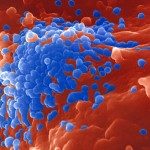Lien vers Pubmed [PMID] – 23941096
BMC Infect. Dis. 2013;13:373
BACKGROUND: Mucosal human papillomavirus (HPV) infection is a necessary cause of cervical cancer. Vaccine and non-vaccine genotype prevalences may change after vaccine introduction. Therefore, it appears essential to rank HPV genotypes according to their oncogenic potential for invasive cervical cancer, independently of their respective prevalences.
METHODS: We performed meta-analyses of published observational studies and estimated pooled odds ratios with random-effects models for 32 HPV genotypes, using HPV-16 as the reference.
RESULTS: Twenty-seven studies yielded 9,252 HPV-infected women: 2,902 diagnosed with invasive cervical cancer and 6,350 with normal cytology. Expressed as (odds ratio [95% confidence interval]), HPV-18 (0.63 [0.51, 0.78]) ranked closest to HPV-16, while other genotypes showed continuously decreasing relative oncogenic potentials: HPV-45 (0.35 [0.22, 0.55]), HPV-69 (0.28 [0.09, 0.92]), HPV-58 (0.24 [0.15, 0.38]), HPV-31 (0.22 [0.14, 0.35]), HPV-33 (0.22 [0.12, 0.38]), HPV-34 (0.21 [0.06, 0.80]), HPV-67 (0.21 [0.06, 0.67]), HPV-39 (0.17 [0.09, 0.30]), HPV-59 (0.17 [0.09, 0.31]), HPV-73 (0.16 [0.06, 0.41]), and HPV-52 (0.16 [0.11, 0.23]).
CONCLUSIONS: Our results support the markedly higher oncogenic potentials of HPV-16 and -18, followed by HPV-31, -33, -39, -45, -52, -58 and -59, and highlight the need for further investigation of HPV-34, -67, -69 and -73. Overall, these findings could have important implications for the prevention of cervical cancer.

